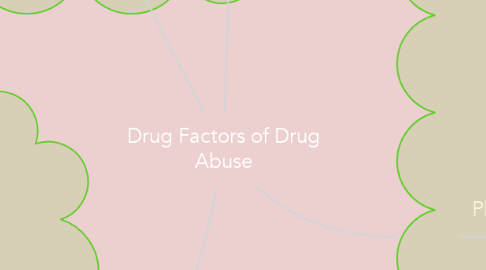
1. Biological
1.1. Genetics
1.1.1. Heritability
1.1.1.1. 40-60% vulnerability to addiction if present in family history. DNA sequences have been identified that indicate a greater risk for addiction. A1 allelle of the dopamine receptor gene, DRD2, is more prevalent in people who are addicted to alchohol or cocaine.
1.1.2. Stages of Development
1.1.2.1. Being born addicted
1.1.2.1.1. possibly predisposed to addiction
1.1.2.2. Exposed at Early Adolescence
1.1.2.2.1. Cognitive formation occurs in early years and can be compromised by early use
1.1.3. Gender
1.1.3.1. Men
1.1.3.1.1. Higher rate of addiction
1.1.3.1.2. More likely to succumb to peer pressure
1.1.3.1.3. Withdrawl symptoms more intense
1.1.3.2. Women
1.1.3.2.1. Become addicted/dependent faster
1.1.3.2.2. Self-medicate
1.1.3.2.3. Suffers from more side effects
1.1.3.2.4. More likely to overdose
1.1.3.2.5. Higher rate of relapse
1.1.4. Mental Disorders
1.1.4.1. Greater risk of use and addiction
1.1.4.2. illicit drugs help with symptoms with less side effects in some cases
1.1.4.3. illicit drugs are more affordable and easier to access
2. Environmental
2.1. Home & Family
2.1.1. Teens are predisposed due to lack of supervision
2.1.2. Teens with strict upbringing can rebel and take risks
2.1.3. Ease of access to drugs and medications
2.1.4. High likelihood of use when others in the home use as well
2.1.5. Stress or early exposure to stress
2.1.6. Physical or Sexual abuse in the home or traumatic events
2.1.7. Poverty can be a stressor that causes some to turn to drugs
2.2. Peer Influence
2.2.1. Association with peers who participate in risky behavior
2.2.2. Peer Pressure
2.3. Academic and Work Life
2.3.1. Failure to meet goals
2.3.2. Poor attendance
2.3.3. Loss of employment or failure from school
3. Pharmacological
3.1. Physical Dependence
3.1.1. Opioids
3.1.1.1. release of endorphins, increase feelings of pleasure
3.1.1.2. Withdrawal symptoms
3.1.1.2.1. CNS irritability
3.1.1.2.2. Excessive Pain
3.1.1.2.3. Nausea, vomiting, diarrhea
3.1.1.2.4. Restlessness
3.1.1.2.5. Diaphoresis
3.1.1.2.6. Tachycardia
3.1.1.2.7. Anxiety
3.1.2. Alcohol
3.1.2.1. feelings of euphoria and relaxation
3.1.2.2. Withdrawal Symptoms
3.1.2.2.1. Convulsions
3.1.2.2.2. Delirum
3.1.2.2.3. Vomiting
3.1.2.2.4. Depression
3.1.2.2.5. Anxiety
3.1.3. Amphetamines
3.1.3.1. stimulants
3.1.3.2. Withdrawal Symptoms
3.1.3.2.1. Anxiety
3.1.3.2.2. Fatigue
3.1.3.2.3. Appetite Changes
3.1.3.2.4. Concentration problems
3.1.3.2.5. Fasciculations
3.1.3.2.6. Aches & Pains
3.1.3.2.7. Nightmares
3.1.4. Hallucinogenics
3.1.4.1. increased sensations, synthesia, psychedelics, dissociatives
3.1.4.2. Withdrawal Symptoms
3.1.4.2.1. Paranoia
3.1.4.2.2. Visual Distortion
3.1.4.2.3. Seizures
3.1.4.2.4. Rhabdomyolysis
3.1.4.2.5. Diaphoresis
3.1.4.2.6. Hyperthermia
3.1.5. Cannabis
3.1.5.1. Slow, calming, relaxed feeling
3.1.5.2. Withdrawal Symptoms
3.1.5.2.1. Irritability
3.1.5.2.2. Insomnia
3.1.5.2.3. Anger
3.1.5.2.4. Depression
3.1.6. Barbituates
3.1.6.1. loss of consciousness, calming, inability to feel pain
3.1.6.2. Withdrawal Symptoms
3.1.6.2.1. Seizures
3.1.6.2.2. Hallucinations
3.1.6.2.3. Fever
3.1.6.2.4. Diaphoresis
4. Social
4.1. Bonding
4.1.1. Forming friendships over use
4.1.2. Fitting in with a new group
4.1.3. Forming a sense of community
4.1.4. Social Inclusion
4.2. Social Media
4.2.1. Celebrities posting pictures of glamourous lifestyles while drinking
4.2.2. Drug exposure through marketing
